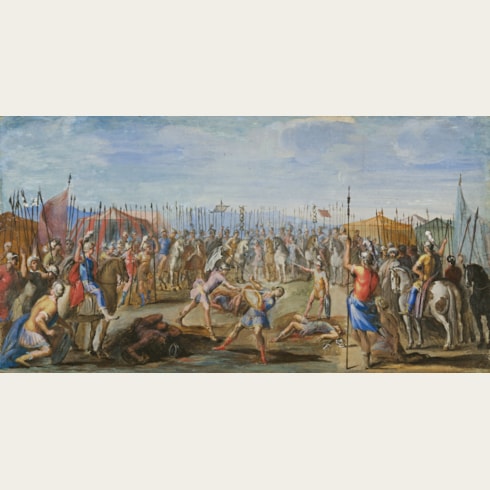Francesco ALLEGRINI
(Gubbio 1624 - Rome c.1680)
Six Drawings of Various Subjects
Sold
Each drawing in pen and brown ink, and all laid down onto one mount.
Five sheets numbered in pen and ink at the lower right.
Various sizes. Overall mount size: 314 x 229 mm. (12 3/8 x 9 in.)
Five sheets numbered in pen and ink at the lower right.
Various sizes. Overall mount size: 314 x 229 mm. (12 3/8 x 9 in.)
These six small drawings are typical examples of the artist’s spirited draughtsmanship, and seem to have been mounted together at some point in the late 18th or early 19th century. Stylistically comparable drawings may be found among the large group of studies by the artist in the collection of The Metropolitan Museum of Art in New York.
A similar group of four drawings by Allegrini mounted together on one sheet appeared on the art market in Paris in 1974.
A similar group of four drawings by Allegrini mounted together on one sheet appeared on the art market in Paris in 1974.
The son of the painter Flaminio Allegrini, who is documented as working in Rome between 1625 and 1635, Francesco Allegrini was mostly active in Rome in the middle of the 17th century. He is thought to have been a pupil and follower of Cavaliere d’Arpino (who may also have trained his father), before entering the studio of Pietro da Cortona. He was elected to the Accademia di San Luca in 1655, together with Pierfrancesco Mola, and enjoyed a productive career as a fresco painter. Allegrini received commissions from many of the leading Roman noble families, including the Mattei, Aldobrandini, Colonna and Altieri. For Pope Innocent X he frescoed the Palazzo Pamphili with scenes from the story of Dido and Aeneas between 1658 and 1660, while for Pope Alexander VII he contributed to the decoration of the Vatican logge. Allegrini was also active in the Roman churches of Sant’Agnese, Santi Domenico e Sisto, San Marco and the convent of Santa Maria sopra Minerva. He painted a number of works in his native Gubbio around 1660 and may also have worked in Genoa.
Allegrini was a prolific draughtsman, although only rarely can his drawings be connected with known paintings or frescoes. He worked mainly in pen and ink, but also in chalk and wash and sometimes gouache. As has been noted by one scholar, ‘The best characterization of Francesco’s drawings is still that given in 1924 by Herman Voss, who was the first to discuss the artist as a draughtsman. He stressed his natural gift for drawing and his taste for the minute; he saw the essence of his graphic art in the graceful, appealing penmanship.’
Large groups of drawings by Allegrini, characterized by rapid, sketchy penwork and relatively small dimensions, are in the National Gallery of Scotland in Edinburgh, the Teyler Museum in Haarlem and the Metropolitan Museum of Art in New York. Four albums containing nearly six hundred drawings by the artist (although some may be the work of his father Flaminio) are in the Museum der bildenden Künste in Leipzig, while an album of over two hundred drawings, apparently from the collection of the Odescalchi family in Rome, appeared at auction in London in 1973 and was later in a private collection in Germany. A further album of landscape drawings, also in a private collection, has recently been attributed to Allegrini.
Allegrini was a prolific draughtsman, although only rarely can his drawings be connected with known paintings or frescoes. He worked mainly in pen and ink, but also in chalk and wash and sometimes gouache. As has been noted by one scholar, ‘The best characterization of Francesco’s drawings is still that given in 1924 by Herman Voss, who was the first to discuss the artist as a draughtsman. He stressed his natural gift for drawing and his taste for the minute; he saw the essence of his graphic art in the graceful, appealing penmanship.’
Large groups of drawings by Allegrini, characterized by rapid, sketchy penwork and relatively small dimensions, are in the National Gallery of Scotland in Edinburgh, the Teyler Museum in Haarlem and the Metropolitan Museum of Art in New York. Four albums containing nearly six hundred drawings by the artist (although some may be the work of his father Flaminio) are in the Museum der bildenden Künste in Leipzig, while an album of over two hundred drawings, apparently from the collection of the Odescalchi family in Rome, appeared at auction in London in 1973 and was later in a private collection in Germany. A further album of landscape drawings, also in a private collection, has recently been attributed to Allegrini.





